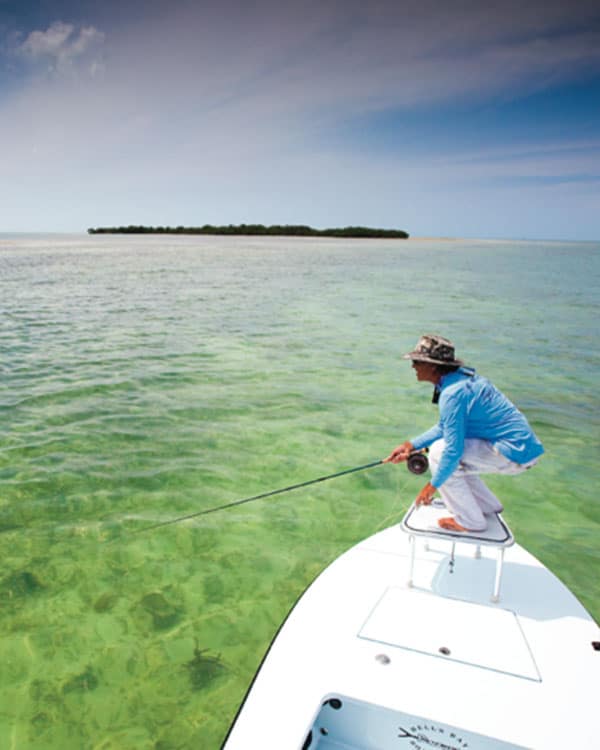For tarpon freaks like me, that 5 a.m. drive along U.S. Highway 1, where it takes you barreling out across the bridges of the Florida Keys, is magical. As the caffeine kicks in and the Steve Miller Band blasts out of the stereo, the first light of dawn plays across the eastern horizon and wild images of skyrocketing silver kings fill my head.
I have more reason than most to be excited. Up ahead, the taillights of the trailer and skiff that I’m fol- lowing belong to the one and only Andy Mill.
If you don’t know who Andy Mill is, where have you been?
For anyone who’s been washed up on a desert island for the last 20 years, let’s just say that Andy Mill has caught more tarpon
than you can shake a stick at and has won any number of tourna- ments — including the prestigious Tarpon Gold Cup no fewer than five times. Andy’s book, A Passion for Tarpon, is a classic, and is the undisputed bible for tarpon fly-fishers everywhere. In short, when it comes to tarpon, Andy is the man, and every minute on the water with him is a genuine master class. Andy’s son Nicky is the living proof: At 18, Nicky is already spotting fish, nailing casts and beating up fish like a pro. He is also a chip off the old block — good-natured, great company and an absolute credit to his old man.
I met Andy on a photography assignment two years ago and we instantly hit it off. When Andy invited me to Florida to fish with him, I all but bit his hand off.
Last year, Andy took me out in his immaculate skiff, and I spent an unbelievable day being guided by the man himself. Andy is a great teacher — full of encourage- ment and constructive advice. He showed me some of the super- stealthy casts that he employs to present the fly, and how to use subtle movements of the rod tip and an ultraslow, smooth draw to keep the marabou-tail toad fly tantalizingly alive. I’d read Andy’s book cover to cover, but to see the master in action was a real educa- tion, and I felt genuinely privi- leged to be out on a bluebird day with arguably the greatest tarpon fly-fisher who has ever lived.
The highlight of that golden day was the moment that Andy put me onto a big, laid-up fish of around 125 pounds that lit up the wide Florida skies in a blur of wild silver magic, before opening up the stout hook like it was a paper clip. That fish has been careening around my dreams ever since, and I counted down the days until this year’s trip like the proverbial kid waiting for Christmas.
Now I’m back, and after helping Andy and Nicky launch the skiff, we are suddenly fizzing across the mirror-bright sea, the big golden sun breaking over the horizon
and winking at us through the stanchions of the bridge as we
run north. I feel the rush of early- morning adrenaline that all avid tarpon-fishers will know. We snake through a narrow cut and sud- denly we are oceanside, the clean, clear Atlantic waters racing by as we head for one of Andy’s secret spots.
Nicky offers me the rod, but I urge him to jump up front, keen to get some images “in the can” and also more than happy to enjoy the sight of father and son fishing together. Andy twirls the push pole and, in a moment, we are gliding effortlessly over the turtle grass, looking for the patches of white sand that will betray the tarpon in the low, livid light of the dawn.
Andy sets us up, and no sooner have we staked out on a gorgeous, glassy flat than a pod of triple- digit fish rolls our way through the silvery surface of the ocean. There’s no time to turn the boat, but Nicky isn’t the least bit phased and goes straight into an elegant backhand shot — a brilliant pin- point cast that puts the fly right on the money. The lead fish doesn’t disappoint: It inhales the fly in a heartbeat and Nicky explodes his hands in classic textbook style.
The fish feels the steel, and I train the camera on the huge frothing boil, but the big tarpon refuses to give me the money shot. Rather than soaring up
into the early morning air, she plunges deep and sets off on a long, dogged subsurface run. With no other anglers around, Andy is able to follow the fish with the motor, keeping the distance between fish and angler to a minimum, so that Nicky can exert maximum pressure. Trusting his knots and the smooth, even drag of the reel, Nicky pulls hard on the fish, knocking the big tarpon over whenever she tries to grab a gulp of air. Despite Nicky’s faultless technique, the battle is a protracted one — the fish refuses to burn herself up with big runs or classic vaulting cartwheels, instead skulking close to the boat. A jet-black storm paints itself across the canvas of the eastern skies and is clearly coming our way, but Nicky grits his teeth and works hard on the fish. Finally, the young protégé draws the fish to the skiff, and Andy leans over and grabs the mighty king with both hands. A magnificent 110-pound tarpon lies beaten, and as Andy gently frees the hook, the first big gobs of rain start to fall all around.
The storm sends us scuttling back to a nearby dock, and I think that perhaps our day is at a premature end as we stand in a tackle-store doorway, sipping coffee and watching the sheets of rain lashing the slipway.
Then we get lucky — the omi- nous black thunderheads drift south, and in a flash, we are jump- ing back in the skiff and working our way quietly back onto the flats. Despite his protests, I insist that Andy jump up front, still hop- ing to get that high-flying money shot of a big, airborne tarpon.
As we stake out a classic ambush on the long, white flat, Andy tells me about some of the new techniques that he has been developing. After a decade and more of relying on the ubiqui- tous Tarpon Toad, throwing it out ahead of the fish, using the fly’s inherent neutral buoyancy to keep it high in the water column, and intercepting the tarpon with that classic bump and slide, Andy has recognized that the Keys fish are less inclined to eat the toad than they once were. over the past couple of years, Andy has become increasingly intrigued by the importance of the palolo worm hatch and its apparent relation- ship to spawning times: Andy suspects that the worms may contain a protein or perhaps even some kind of aphrodisiac that is important to the tarpon immedi- ately prior to their spawning cycle.
Others, like tournament angler David Dalu, have done really well using constant stripping tech- niques with palolo imitations, and when fishing the oceanside flats, Andy has started to use worm flies not just at the time of the hatch but right through the season, from mid-April through June. The tech- nique has paid huge dividends.
Rather than hovering the fly in the style of toad fishing and using relatively slow, subtle twitches to induce the take, Andy is now increasingly tending to imitate the worm, retrieving the fly hand over hand in order to emulate the constant swimming motion of the worm. He’ll throw a long cast well past the line that a tarpon is tracking, and then, gripping the rod under his arm or between his knees, he will retrieve with a constant, double-handed strip in order to bring the fly across the path of the tarpon in a way that offers it a very easy meal. Andy thinks that the fish traveling down the Keys are not really that interested in feeding, at least not during daylight. However, serve them up a tasty, protein-laden snack and they might just make that “impulse buy.” Andy’s fly box is testament to his faith in the new methodology, stuffed as it is with as many worm flies as toads.
Another method Andy has been pioneering involves a tiny mara- bou shrimp fly. When I first see the pattern, I’m convinced that I am looking at a large bonefish fly — a subtle little tan shrimp on a Size 1 hook, but Andy leaves me in no doubt that it can deliver the goods.
As if to prove the devastating effectiveness of this latest pattern, Andy first shows me how the fish can and often do react to the faithful old standby, the Tarpon Toad. Despite perfect casts, when he shows the classic pattern to a couple of good-size fish, they steadfastly refuse it. Second, Andy shows me the new worm fly technique: We see a long string of perhaps 200 fast-moving fish, but again, despite showing some interest, the fish decline to eat.
Then my host twists my arm to put the camera away and jump up front. Aware that I don’t yet have that classic shot of the big air- borne Megalops atlanticus under my belt, I attempt to argue, but the thought of another long string of silver treasures coming down the flat is impossible to resist.
As I pack away the cameras, I am conscious that Andy is changing out the fly, and when he passes me his 11-weight, I find that he has attached the tiny shrimp
fly to a 60-pound fluorocarbon shock tippet that barely squeezes through the eye of the hook. Mindful of the tiny hook, I want to protest, but Andy just laughs and tells me to have faith.
After throwing the fly too close to one tarpon, which simply swims under it, Nicky suddenly shouts, “9 o’clock! 9 o’clock! Jeeeez, they’re everywhere!”
Wheeling left, I am confronted by a truly huge string of fish. The fish are moving fast. Andy talks me through the presentation, telling me to always throw to the oncom- ing fish in the line. After one momentary hookup, I get a sec- ond chance. I hold my breath and watch a beautiful, rock-hard fish of around 80 pounds rise slightly in the water column and noncha- lantly inhale the tiny fly. I set the hook and, of course with cameras safely stowed, the fish erupts into the fabulous, high-flying tour de force that marks these majestic, chrome-bright leviathans as the ultimate saltwater prize.
After 20 minutes of demented, cartwheeling mayhem, the fish is finally beaten. As Andy leans out to grab it, I gaze at the fish’s vast, armor-plated flanks, its silver scales gleaming in the late- afternoon sunshine.
I feel a wave of guilt for having put the camera down — the fish would have provided some epic images as it cavorted around the boat — but catching an 80-pound tarpon with good friends takes some beating, and the remorse lasts about two seconds flat. Andy eases out the tiny shrimp fly and holds it up for me to inspect, ask- ing with a grin what I think of his “bonefish” fly now.
Nicky carefully and expertly revives the fish, and we watch as the mirror-scaled behemoth glides back into the crystalline waters
of the Keys. Watching these big beasts rocket up into the sky is surely the biggest kick in saltwater fly-fishing, but watching them go back safely to continue on their epic journey runs a close second.
As I drive back to Miami’s air- port, grinning like a Cheshire cat, I know I’m lucky — fishing with Andy Mill is the equivalent of play- ing golf with Tiger Woods, and few get to enjoy the privilege. Watching Andy and Nicky fish together is to witness a rare exhibition of talent. We live in an age when most kids turn on the tube or plug in the Xbox for their kicks. To see a father and his son full of the singular excitement that tarpon fishing brings, trading banter and laugh- ing in the Florida sunshine, not to mention putting some fabulous fish in the air, is a memory that will stay with me for a very long time.
Andy, Nicky, thank you.
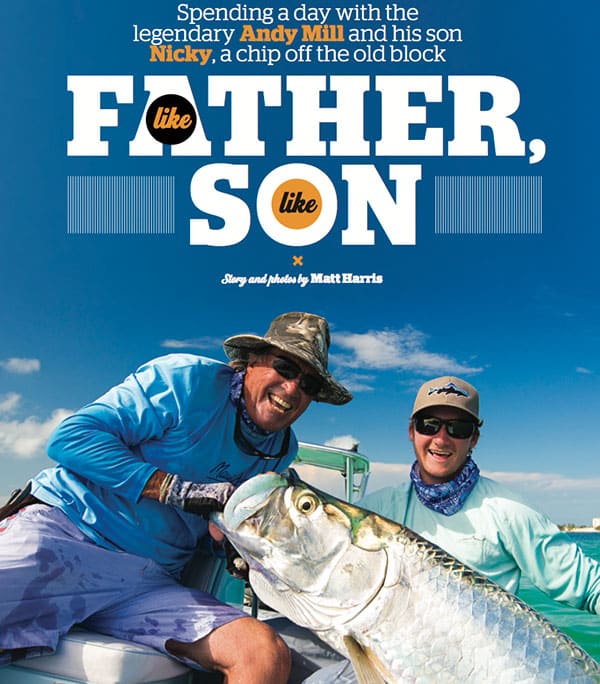
Fly Fishing Father and Son
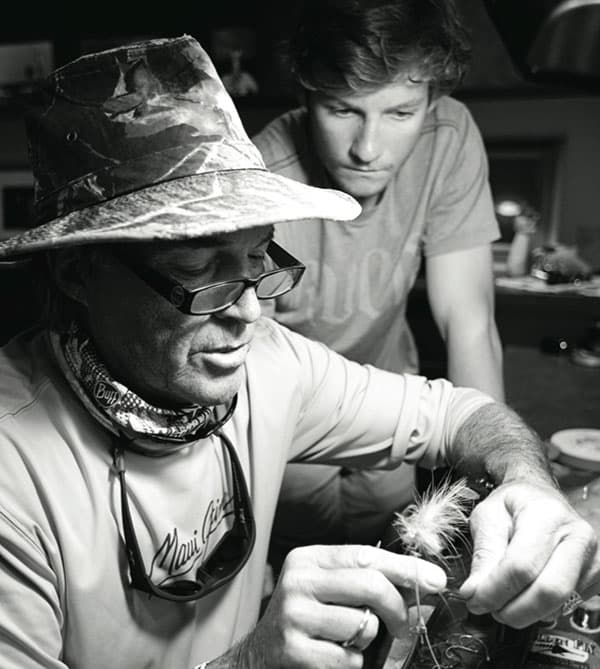
Fly Fishing Father and Son
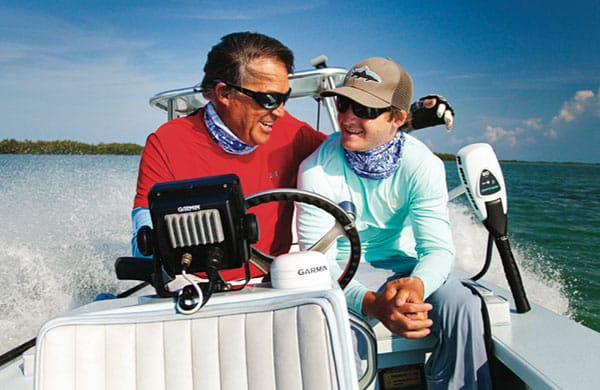
Fly Fishing Father and Son
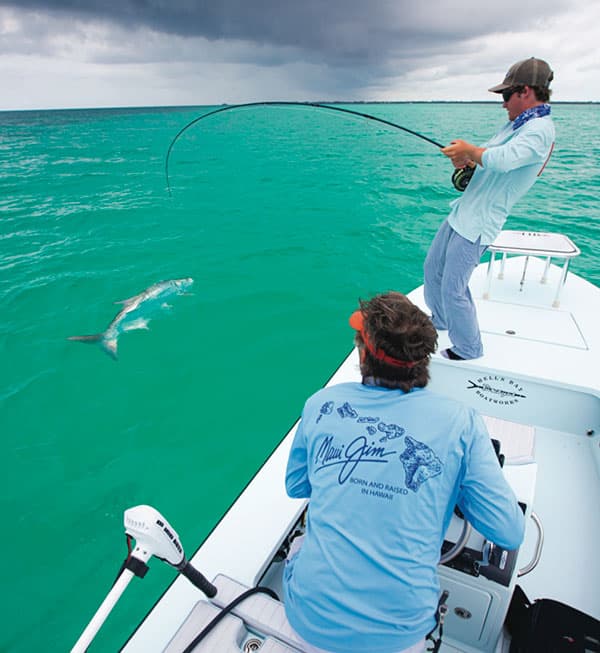
Fly Fishing Father and Son
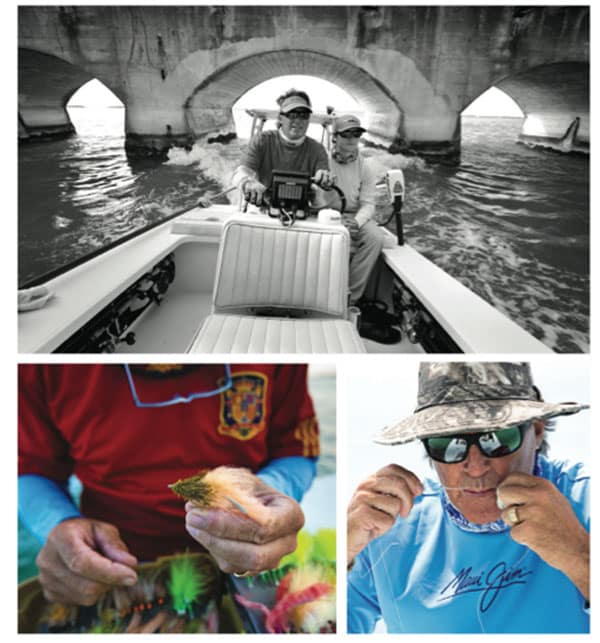
Fly Fishing Father and Son
